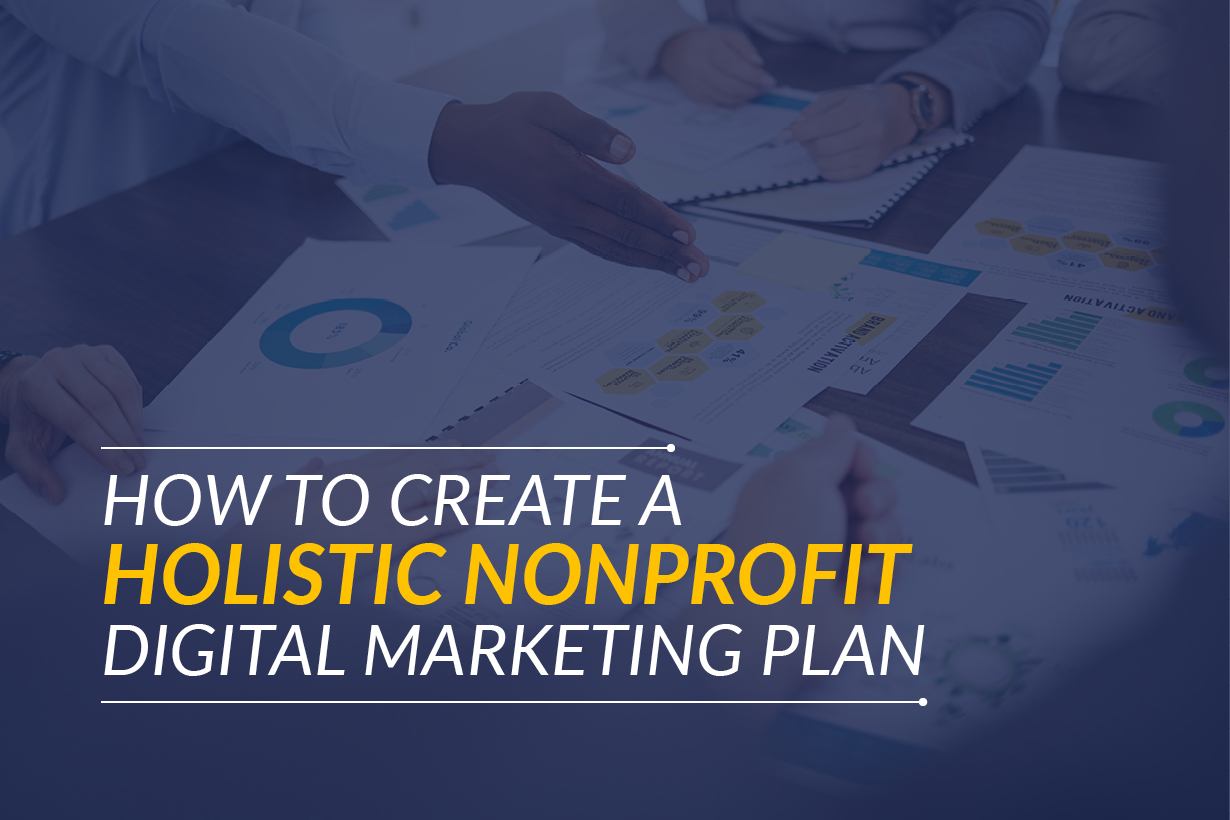
Your nonprofit invests significant time, energy, and money into bettering the lives of those you serve. However, you can’t do it all on your own. Building relationships with donors, volunteers, and advocates ensures that you have a reliable source of support to power your mission year after year.
Thanks to modern technology, the world is more interconnected than ever. This means that there are more opportunities to tell your nonprofit’s story, spread awareness of your cause, and connect with donors around the world.
A holistic nonprofit digital marketing plan involves weaving together multiple channels and strategies into a unified approach that resonates with your target audience. Follow these four essential steps to tap into the full potential of digital marketing.
1. Outline your digital marketing goals.
Before you start crafting your messages, it’s important to define clear goals to guide your digital marketing activities. Use the SMART framework to get all of your team members on the same page:
- Specific. Hone in on what you’d specifically like to accomplish through digital marketing, whether that’s recruiting more volunteers, encouraging more people to join your recurring gifts program, or increasing your number of followers on a platform.
- Measurable. Identify key performance indicators (KPIs) that your team can track to evaluate your progress toward your goal. These allow you to determine whether the actions you’re taking are actually contributing toward the results you want to see.
- Achievable. Your goal should be challenging, but not impossible to accomplish based on your staff’s time and resources.
- Relevant. Make sure that your goal is relevant to your overall mission and that it will help you improve how you make an impact.
- Time-bound. Set a deadline for your goal, so that your staff and volunteers can work actively and urgently toward it.
For example, let’s say that your nonprofit is trying to raise more funds by securing more matching gifts. You might set a SMART goal like this: “Increase the number of matching gifts we receive by 15% before April of next year through informational social media posts and personalized email outreach to match-eligible donors.”
2. Segment your audience.
Marketing is not just about producing powerful content and sharing it on your platforms. You need to find ways to resonate with the people you’re trying to reach if you want to turn interest into action.
Use your donor database to segment your audience based on relevant characteristics such as:
Alt Text: Three elements to consider when segmenting your audience as part of a holistic nonprofit digital marketing plan.
- Supporter type. Are they a first-time donor? A regular volunteer? A potential corporate partner? Adjust your messages based on the supporter’s relationship with your nonprofit.
- Communication preferences. Do many of your donors prefer receiving updates on social media? Or are many of them subscribed to your email newsletter? Use these insights to determine which channels to prioritize sending your messages through.
- Demographics. Factor in details such as age, geographical location, and employment to write appeals and promote opportunities that your audience members will be receptive to.
If you have any gaps in your data, consider sending out surveys to collect more information on how audience members prefer to hear from your nonprofit and what type of content they’re most interested in consuming.
3. Choose your digital marketing channels.
According to Getting Attention’s nonprofit digital marketing guide, while taking a multichannel approach is most useful for maximizing your reach, it’s still important to select your platforms wisely to avoid spreading your efforts too thin. Explore these popular online marketing channels to figure out which ones to incorporate into your plan:
Sending emails is both a cost-effective and convenient way to stay connected with your supporters, whether you’re following up after a donation or promoting an upcoming event. However, it can be challenging to stand out in an inbox full of other demanding emails.
Use the following tips to craft click-worthy emails for your nonprofit:
- Ensure that your emails are mobile-responsive so supporters can view them on any device.
- Use short, eye-catching subject lines that create a sense of urgency.
- Include clear calls to action (CTAs) to prompt audiences to take the intended next step.
If you don’t already have one, consider launching a recurring email newsletter that allows you to supply your subscribers with the latest news about your nonprofit, upcoming event details, and volunteer opportunities.
Search Ads
Search ads are a highly effective way to reach new and existing audience members who are likely to be interested in your cause. Plus, by applying for the Google Ad Grant program, you can gain access to a $10,000 stipend to spend on Google Ads every month.
Before you can start unlocking the benefits of this game-changing opportunity, your nonprofit needs to:
- Be registered as a 501(c)(3) organization.
- Have a functional, high-quality website.
- Create a Google for Nonprofits account.
- Submit a Google Grant application.
After you’re approved, you’ll be able to use your monthly $10,000 to bid on keywords relevant to your nonprofit’s mission. Then, you can incorporate those keywords into ads that will appear at the top of Google’s search results for those terms.
Social Media
Social media has become a popular way for people around the world to stay in touch, share news, find products to purchase, and support causes they care about. The typical social media user spends about 2 hours and 24 minutes each day visiting an average of 6.7 different platforms. Because of this, it’s important to meet your audience where they already are and find ways to strengthen your nonprofit’s social media presence.
Beyond posting regularly, use social media to deepen your relationships by:
- Engaging in two-way conversations with individual supporters.
- Hosting live Q&As to provide opportunities for more meaningful interactions.
- Encouraging supporters to host birthday fundraisers on your nonprofit’s behalf.
Social media makes it possible for donors and volunteers to engage with your nonprofit when and where it’s most convenient for them. For those who enjoy using their mobile devices, take your marketing one step further by inviting them to opt into receiving text communications from your organization.
4. Plan a variety of engaging content.
Once you’ve decided on your digital marketing channels and how you’ll use them to appeal to your target audience, it’s time to create a content calendar that encompasses a variety of attention-grabbing formats. Plan to share impact stories, video clips from previous fundraising events, relevant statistics, behind-the-scenes tours, and more.
NXUnite recommends many free nonprofit marketing tools that you can use to produce eye-catching graphics, schedule social media posts, and enhance your marketing copy. Just be sure to maintain consistent branding across your content so that supporters can easily associate it with your nonprofit.
And don’t forget that your content can be used across multiple platforms! You can share impact statistics via both email and social media. You can share donor impact stories on your website and on your digital donor wall. Reusing graphics and other content can be an easy way to maximize your impact without needing to invest additional resources.
After you’ve put your nonprofit digital marketing plan into action, schedule weekly meetings to review your KPIs, from your email click-through rates to your number of YouTube subscribers. Use these opportunities to determine how you can improve your marketing efforts moving forward. For instance, you might decide to add emojis to your email subject lines to make them stand out more or create custom video thumbnails to attract more viewers.
By refining your marketing plan as you go, you’ll set your nonprofit up to meet its goals with greater ease and efficiency.
Jessica King, Business Lead at Getting Attention
Jessica helps nonprofits acquire and manage the Google Ad Grant to expand their impact. Prior to her  work at Getting Attention, Jessica worked in nonprofit and higher education organizations focusing on communication and digital marketing, and most recently in search engine optimization in the mission-driven sector. Jessica holds a master’s degree in communication from Virginia Tech. In her free time, you can find her reading, building furniture, and hanging out with her cats, Benny and Olive
work at Getting Attention, Jessica worked in nonprofit and higher education organizations focusing on communication and digital marketing, and most recently in search engine optimization in the mission-driven sector. Jessica holds a master’s degree in communication from Virginia Tech. In her free time, you can find her reading, building furniture, and hanging out with her cats, Benny and Olive

















 I can’t wait to meet with you personally.
I can’t wait to meet with you personally.
Comments on this entry are closed.